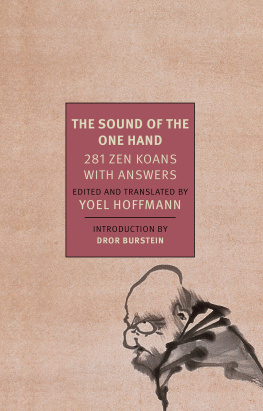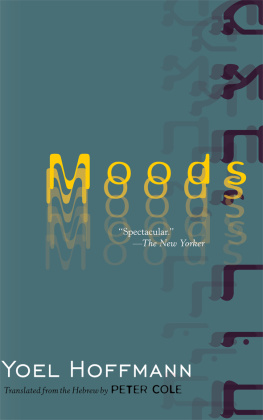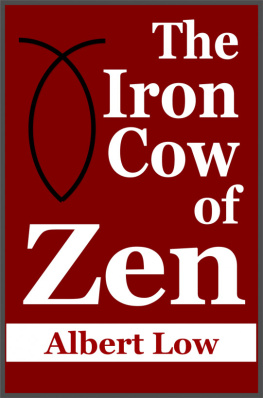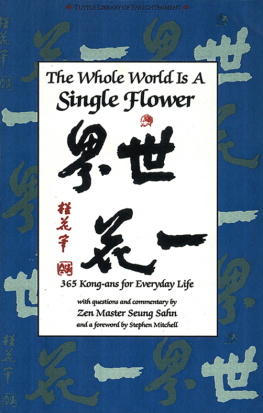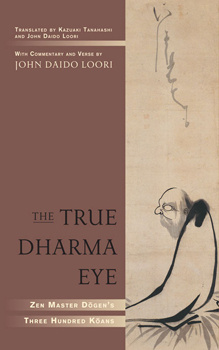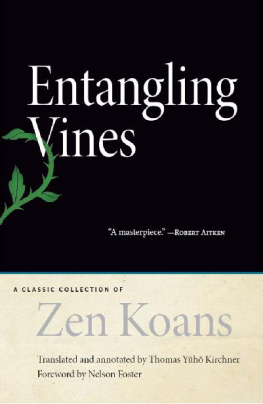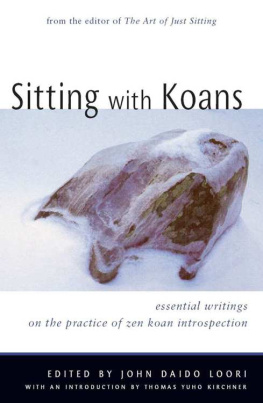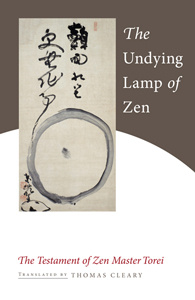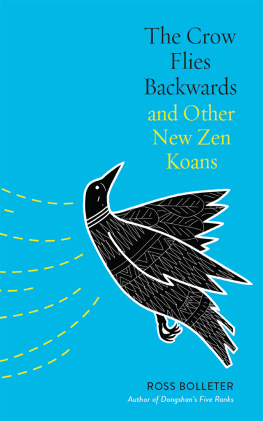THE SOUND OF THE ONE HAND
281 Zen Koans with Answers
Translated from the Japanese and with commentary by
YOEL HOFFMANN
Introduction by
DROR BURSTEIN
Foreword by
ZEN MASTER HIRANO SJ
NEW YORK REVIEW BOOKS

New York
THE SOUND OF THE ONE HAND
YOEL HOFFMANN was born in 1937. He received his PhD in the philosophy of religion and Buddhism from Kyoto University, Japan, and went on to teach Eastern philosophy at the University of Haifa. In addition to his works of fiction, he is the author of several books on Zen Buddhism, comparative philosophy, and Japanese poetry. Hoffmann has been awarded the Koret Jewish Book Award, the Newman Prize of Hebrew Literature by Bar-Ilan University, and the Bialik Prize by the city of Tel Aviv. He lives in the Galilee.
DROR BURSTEIN teaches literature at Tel Aviv University. He is the editor of the poetry journal Helikon and the recipient of the 1997 Jerusalem Prize for Literature. His books Kin and Netanya have been translated into English.
THIS IS A NEW YORK REVIEW BOOK
PUBLISHED BY THE NEW YORK REVIEW OF BOOKS
435 Hudson Street, New York, NY 10014
www.nyrb.com
Translation and commentary copyright 1975 by Yoel Hoffmann
Introduction copyright 2010 by Dror Burstein; translation copyright 2016 by Ilana Kurshan
All rights reserved.
The introduction by Dror Burstein was originally published in the Hebrew edition of this book, published by Keter Books in 2010, and is used by permission.
Cover image: Sui Genro, Seated Bodhidharma, eighteenth century; the Gitter-Yelen Foundation
Cover design: Katy Homans
Library of Congress Cataloging-in-Publication Data
Names: Hau H, author. | Hoffmann, Yoel, editor, translator.
Title: The sounds of the one hand : 281 Zen koans with answers / edited by Yoel Hoffman ; introduction by Dror Burstein.
Description: New York : NYRB Classics, 2016. | Series: New York Review Books Classics
Identifiers: LCCN 2016019582| ISBN 9781681370224 (paperback) | ISBN 9781681370231 (ebook)
Subjects: LCSH: Rinzai (Sect)Controversial literature. | BISAC: PHILOSOPHY / Zen. | RELIGION / Buddhism / Zen (see also PHILOSOPHY / Zen). | BODY, MIND & SPIRIT / Spiritualism.
Classification: LCC BQ9369 .H38213 2016 | DDC 294.3/927dc23
LC record available at https://lccn.loc.gov/2016019582
ISBN 978-1-68137-023-1
v1.0
For a complete list of titles, visit www.nyrb.com or write to: Catalog Requests, NYRB, 435 Hudson Street, New York, NY 10014
CONTENTS
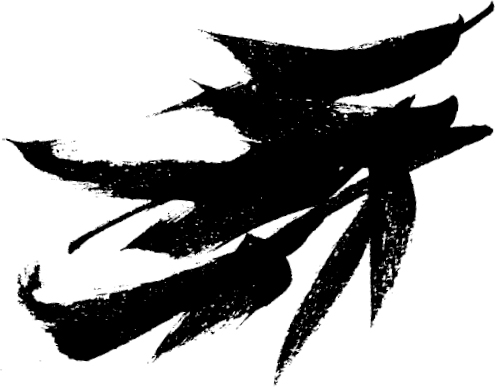
TRANSLATORS NOTE
This book contains all the koans which the Zen novice has to answer during the long course of his training for qualification as a Zen master, together with their traditional answers. My decision to bring the translation of this book before the general public was not easily made, and I am well aware that there will be Zen masters and Zen disciples in Japan and elsewhere who may regard such a publication with discomfort. One can hardly expect the teachers and disciples of a religious sect to welcome the publication of the secrets of their sect.
Since the publication of this book in 1916 and its republication in 1917, there has been no new edition. In Kyoto, only a photocopy of it is sold in a shop that specializes in Buddhist literature. To the best of my knowledge, this book cannot be found in libraries, nor does it appear in bibliographies on Buddhism or Zen. I have been told by the shop owner in Kyoto that almost all the buyers of the book are Zen novices. A certain Japanese Zen master told me that he had tried to compose his own koans in order to prevent his novices from relying on the answers in the book. He admitted, however, that he found it extremely difficult and was, in the end, forced to rely on the traditional koan teaching as presented in this book.
Though the teaching of Zen was introduced into Japan as early as the seventh century, it was not until the beginning of the eighteenth century that the koans were first systematized into the traditional method of teaching presented here. It was the Japanese Zen Master Hakuin (16861769) who first selected the koans in this book from among those recorded in Chinese sources. (There are close to two thousand recorded koans altogether.) It was he who also determined the order of their presentation to novices and composed many of the traditional answers. Hakuin created many koans of his own, the most famous of them being the koan on the sound of the one hand. This system was further developed by Hakuins disciples, Inzan Ien (17511814) and Takuj Kosen (17601833), into the teaching method which has prevailed in Japan until the present day. In the course of time, Hakuins teaching came to be interpreted by a number of different schools, each using the method to give different answers to some of the koans. But these differences are, for the most part, nonessential.
Most scholars of Zen believe that the koans that Hakuin created are still transmitted only by word of mouth to the student in the masters room. It seems that the silence of Japanese scholars and students concerning the existence of this publication was, in effect, a clever method of dealing with the scandal, much more effective than the destruction of the book.
The lack of sources for the answers to the koans has created a serious handicap for researchers on Zen. In Japan, very few Zen masters work on the translation of the koans into modern Japanese; but even those who do, being bound by their vow to reveal the answers only in dokusan (the private meeting between novice and master), are extremely reluctant to refer even to the meaning of koans, not to speak of their answers. Thus scholars who are forced to rely on no more than the Chinese version of the koan have to speculate on the meaning of phrases and expressions which could be clarified if they knew the official answer to the koan, or at least the way the koan was presented and commented upon by the Zen master in private meetings.
Zen research in the West suffers from the same handicap. Because none of the translators knew the answers to the koans, they had to rely upon their own intuitions as to their meanings or on the mood or usage of the particular koan in the context of Zen teaching. As a result, many of the translations, though linguistically possible, have often missed the essential point of a koan. I suspect that even D. T. Suzuki, who introduced Zen to the West a few decades ago, did not know the answers to the koans. His presentation of the doctrine of Zen, its history, and its affinity with other Buddhist schools of thought is scholarly and reliable. However, Zen masters generally agree that his comments on koans are impressionistic and in many cases excessively Western. When Zen began to attract the attention of intellectuals outside Japan, many Westerners took to writing on Zen. Some of these writers, endowed with poetic sensitivity, have given insight into the meaning of some koans. However, comments such as theirs cannot generally convey the rooted attitudes of Zen tradition.
My decision, then, to translate and publish this book was above all motivated by my firm conviction that it would introduce to the Western world the clearest, most detailed, and most correct picture of Zen. In trying to make the translation as clear as possible to the Western reader, I have refrained whenever possible from using terms that would not be understood by a reader with a limited knowledge of Buddhism. Where Buddhist terms were unavoidable, I provided their explanation either in the text itself or in notes. The notes I have added to the koans deal mainly with the philosophical background and the psychological relations between the persons who appear in the koan in question. The notes to the answers are designed, above all, to explain the reasons for the pupils specific response.

